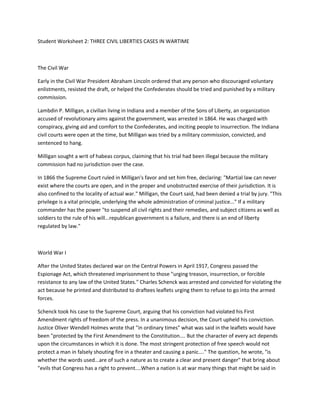
War examples
- 1. Student Worksheet 2: THREE CIVIL LIBERTIES CASES IN WARTIME<br />The Civil War<br />Early in the Civil War President Abraham Lincoln ordered that any person who discouraged voluntary enlistments, resisted the draft, or helped the Confederates should be tried and punished by a military commission.<br />Lambdin P. Milligan, a civilian living in Indiana and a member of the Sons of Liberty, an organization accused of revolutionary aims against the government, was arrested in 1864. He was charged with conspiracy, giving aid and comfort to the Confederates, and inciting people to insurrection. The Indiana civil courts were open at the time, but Milligan was tried by a military commission, convicted, and sentenced to hang.<br />Milligan sought a writ of habeas corpus, claiming that his trial had been illegal because the military commission had no jurisdiction over the case.<br />In 1866 the Supreme Court ruled in Milligan's favor and set him free, declaring: quot; Martial law can never exist where the courts are open, and in the proper and unobstructed exercise of their jurisdiction. It is also confined to the locality of actual war.quot; Milligan, the Court said, had been denied a trial by jury. quot; This privilege is a vital principle, underlying the whole administration of criminal justice...quot; If a military commander has the power quot; to suspend all civil rights and their remedies, and subject citizens as well as soldiers to the rule of his will...republican government is a failure, and there is an end of liberty regulated by law.quot; <br />World War I<br />After the United States declared war on the Central Powers in April 1917, Congress passed the Espionage Act, which threatened imprisonment to those quot; urging treason, insurrection, or forcible resistance to any law of the United States.quot; Charles Schenck was arrested and convicted for violating the act because he printed and distributed to draftees leaflets urging them to refuse to go into the armed forces.<br />Schenck took his case to the Supreme Court, arguing that his conviction had violated his First Amendment rights of freedom of the press. In a unanimous decision, the Court upheld his conviction. Justice Oliver Wendell Holmes wrote that quot; in ordinary timesquot; what was said in the leaflets would have been quot; protected by the First Amendment to the Constitution.... But the character of every act depends upon the circumstances in which it is done. The most stringent protection of free speech would not protect a man in falsely shouting fire in a theater and causing a panic....quot; The question, he wrote, quot; is whether the words used...are of such a nature as to create a clear and present dangerquot; that bring about quot; evils that Congress has a right to prevent....When a nation is at war many things that might be said in time of peace are such a hindrance to its effort that their utterance will not be endured so long as men fight.quot; <br />World War II<br />At the time of the Japanese attack on Pearl Harbor on December 7, 1941, more than 100,000 people of Japanese background lived on the west coast of the U.S. More than half, mostly young people, were American citizens. Most older Japanese were not citizens because U.S. laws at the time did not permit citizenship for them.<br />Within days a report from San Francisco said that 20,000 Japanese living there were ready to attack the city; in Los Angeles radar screens showed unidentified flying objects and antiaircraft guns opened fire; near Seattle reports warned that enemy agents planned huge forest fires in the shape of an arrow aimed at the city. People on the west coast were very jittery.<br />On February 19, 1942, President Franklin D. Roosevelt issued Executive Order 9066, which provided for the removal of all ethnic Japanese, whether they were citizens or not. Forced to leave their homes and most of their belongings, they were first taken to fairgrounds, camps, and racetracks, then moved a few months later to permanent relocation camps in desert and uninhabited areas of California, Arizona, Idaho, Wyoming, Colorado, and Utah. They lived in barracks and worked at unskilled jobs like harvesting sugar beets, for which they earned $8 a month. Doctors and teachers might earn as much as $19.<br />One Japanese man, Fred T. Korematsu, fought efforts to remove him from his home in San Leandro, California, to the Supreme Court. But a 6-3 majority ruled against him. The removal order, the Court said, had resulted from a threat to the security of the United States, not because of hatred of the Japanese or their race. Justice Hugo Black wrote, quot; There was evidence of disloyalty on the part of some. The military authorities declared the need for action was great and time was short.quot; <br />Writing in 1984 in a reopened case that erased Mr. Korematsu's conviction, District Judge Marilyn<br />Hall Patel, said of the earlier decision, quot; It stands as a caution that in times of distress the shield of<br />military necessity and national security must not be used to protect governmental actions from close scrutiny and accountability. It stands as a caution that in times of international hostility and antagonisms our institutions, legislative, executive and judicial, must be prepared to exercise their authority to protect all citizens from the petty fears and prejudices that are so easily aroused.quot; <br />Many years after the war, ethnic Japanese who had suffered relocation received some payment in compensation.<br />